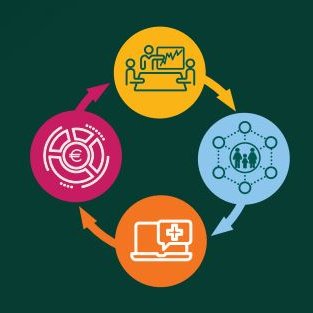Guest blog post by Prof. Regina Connolly, Dublin City University Business School

Healthcare in Ireland is changing radically as a result of demographic, organisational and resourcing factors as well as the increasing proliferation of digital technology. Demographic changes include an ageing population, a rise in the number of people living with long-term conditions and the increased demand and complexity of healthcare services. For example, life expectancy increased in Ireland by 2.4 years between 2005 and 2018 and is now above the EU average. In parallel mortality rates have decreased and people are living longer, even after serious diagnoses such as cancer (Department of Health, 2019).
The population is growing by 60,000 people each year and the profile of the population is also changing: Within a decade, there will be more citizens over the age of 65 years than those that are under 14 years. Of the 1 million people who will be over the age of 65 at the end of that decade, 100,000 of them will in fact be over 80 years of age, a figure that is one third higher than the current situation (CSO, 2018).
These changes have led to a growing realization that our health and social care services have arrived at a critical juncture and need to be completely revisioned in order to accommodate and prepare for the changing national profile. From an organizational perspective, these changes will unquestionably put increasing pressure on what is an already overstretched system. There will be increased demand for the right services as well as the right infrastructure in the right locations. At present, there is geographic variation in the type and availability of services, a situation that is simply not sustainable in light of forecasted demographic changes.
In light of these demographic shifts, organizational changes are clearly required in order to deliver health and social care services in a way that is efficient, effective and sustainable, meeting the health needs of all members of the Irish population. These changes cannot be simply minor adaptations, but necessitate a radical restructuring of Irish healthcare delivery systems. The Irish government’s commitment to these changes is outlined in the Sláintecare programme of reform, Ireland’s eHealth Strategy report and Future Health – A Strategic Framework for Reform of the Irish Health Service. In these reports the government re-articulates its commitment to real
transformation in how healthcare services are visioned, delivered and experienced, as well its commitment to provide significant financial investment to support service reform implementation. This is currently being evidenced in policy decisions. For example, over the next decade the Irish Government’s National Development Plan will provide €10.9 billion additional investment in order to improve the performance of the health service.
MIDAS has the potential to support realization of the government’s objectives within that shifting demographic context and the need for organizational restructuring of the healthcare sector. For example, one of the main implementation Slaintecare objectives is service redesign. By this is meant the redesign of health and social care services for the people of Ireland, a change that is underpinned by the drive to improve the health and wellbeing of the population, and to keep people well in their own communities for as long as possible. Based on the specific needs of the population for each region, as determined by the population health planning process, and based on knowledge of current levels of service delivery and current configuration, the Department of Health and associated health care agencies and partners desire to co-design the service requirements needed for that region’s population.
This can only be achieved in a prioritised way by looking at the whole care pathway from prevention, to early intervention, detection, diagnosis, treatment, rehabilitation and palliative care services. Certain services will need to be planned and delivered nationally, while other services will need to be planned and delivered in an integrated, devolved way at a regional and local level, taking account of national strategies as appropriate. There will be continued focus on developing longer-term capacity to treat people in a timely manner in accordance with Sláintecare waiting time targets.
The successful planning that will lead to realization of these objectives is dependent on heterogeneous data sets being combined from multiple sources and analysed in a way that provides policy makers with a visual understanding of the potential impact of decisions, specifically whether those decisions are likely to achieve their intended outcomes. The objectives of the MIDAS project are therefore directly aligned with the Sláintecare national health reform goals. For example, MIDAS will enable Irish policy makers to vision the economic and social impact of their health decisions on care pathways, health behaviour change and patient empowerment – information that can contribute to future policy decisions. It will provide policy makers with a unique tool for harnessing the wide range of health data that is contained across the system to maximize and support better holistic decision-making, whilst providing an improved experience to users of the platform. Because of this, the outcomes of the MIDAS project have potential to result in improved health service efficiencies, effective data capture and integration for decision- making, resulting in empowered healthier citizens and reduced hospitalisations, all of which are core objectives of the Irish Government’s reform goals.
References
- Department of Health (2019) Cancer, available at https://health.gov.ie/publications-research/statistics/statistics-by- topic/cancer/
- CSO (2018) Population and Labour Force Projections 2017-2051, available at https://www.cso.ie/en/releasesandpublications/ep/p- plfp/populationandlabourforceprojections2017-2051/ populationprojectionsresults/
